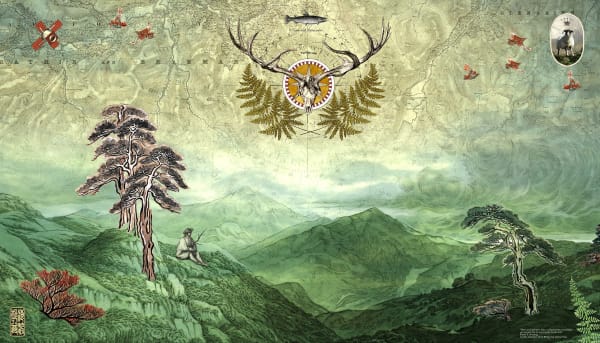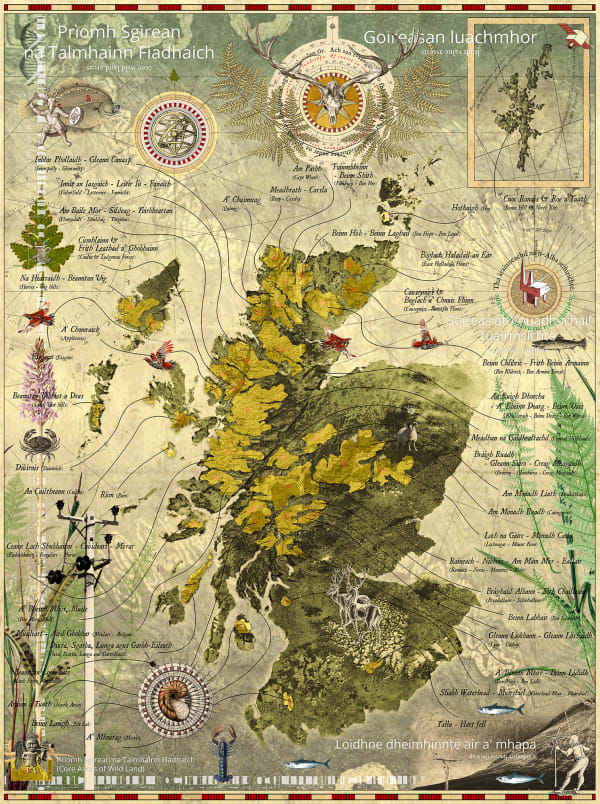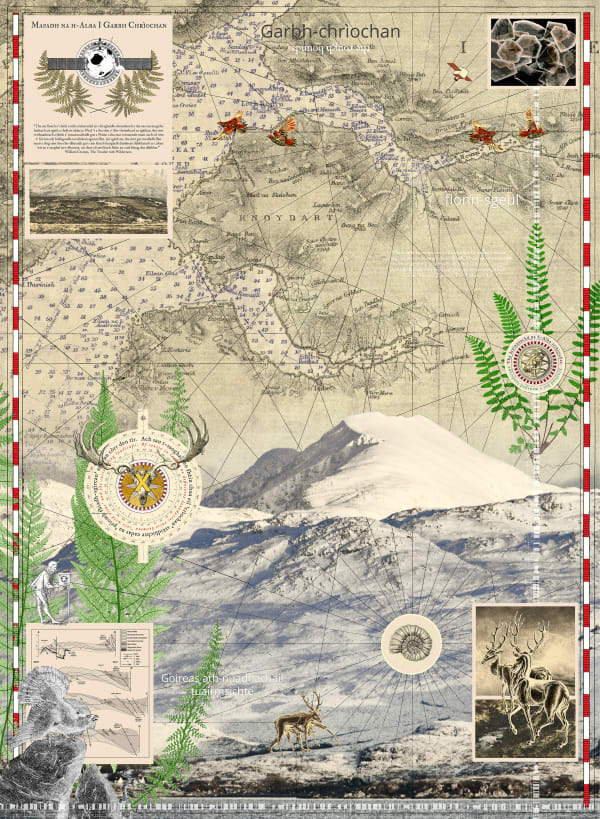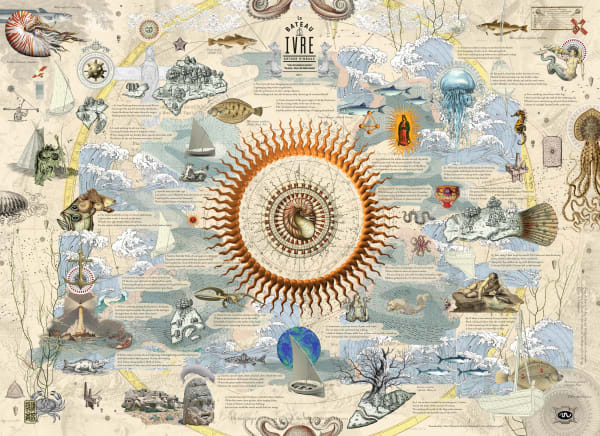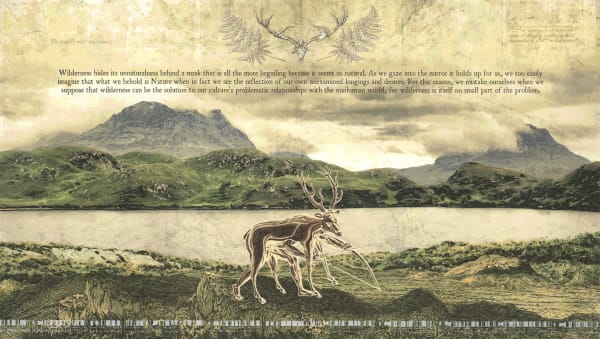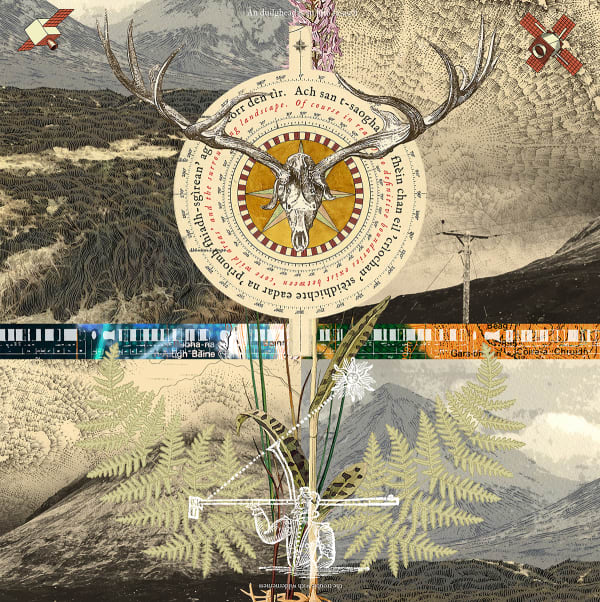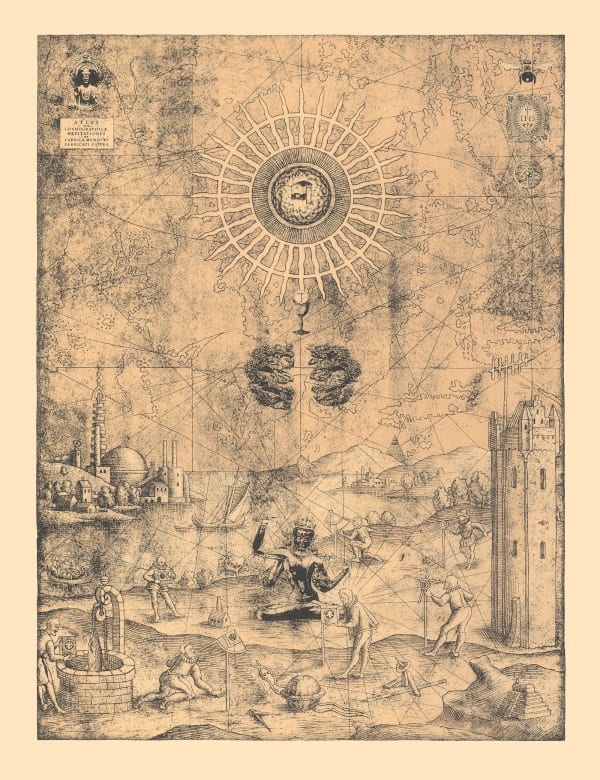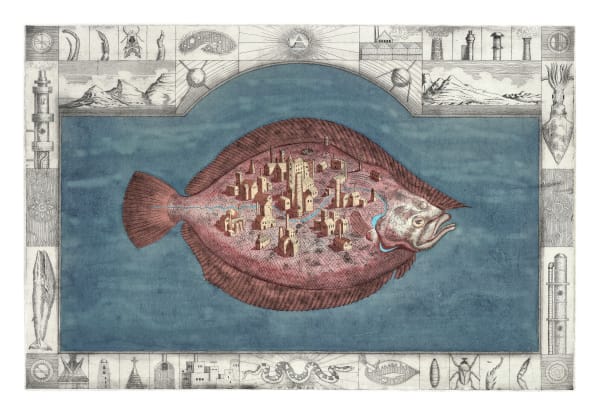Murray Robertson - Uncharted 1985-2025: Printmaking, Maps & Travels: First Floor Gallery
"In the etchings, woodcuts and paintings of Murray Robertson a sense of the alchemical conversion of brute experience into a poetry of the world is restored. The works are enigmatic, absurd, violent and melancholic in turns, yet they are vivid reminders to us of the irreducible strangeness and wonder which attend our place in this world. They offer us a vision of 'reality' which is many-layered; rationally disobedient and symbolically proliferous, thus is a reality in which the spirit and the imagination may live fuller lives." - John Calcutt, 1993.
Glasgow Print Studio presents an exhibition featuring works from Murray Robertson's years at Glasgow Print Studio, following the development of his practice as punctuated and influenced by the range of national and international printmaking projects, residencies and exchanges he has undertaken over the past four decades.
Delving into Robertson's artistic journey, the exhibition and accompanying catalogue traces his evolution as a printmaker through a diverse range of techniques. Uncharted 1985 - 2025 highlights the profound influence of his extensive travels, from the vibrant cultures of Japan, Mexico and India, to the remote landscapes of the Scottish Highlands and Islands, on his artistic vision.
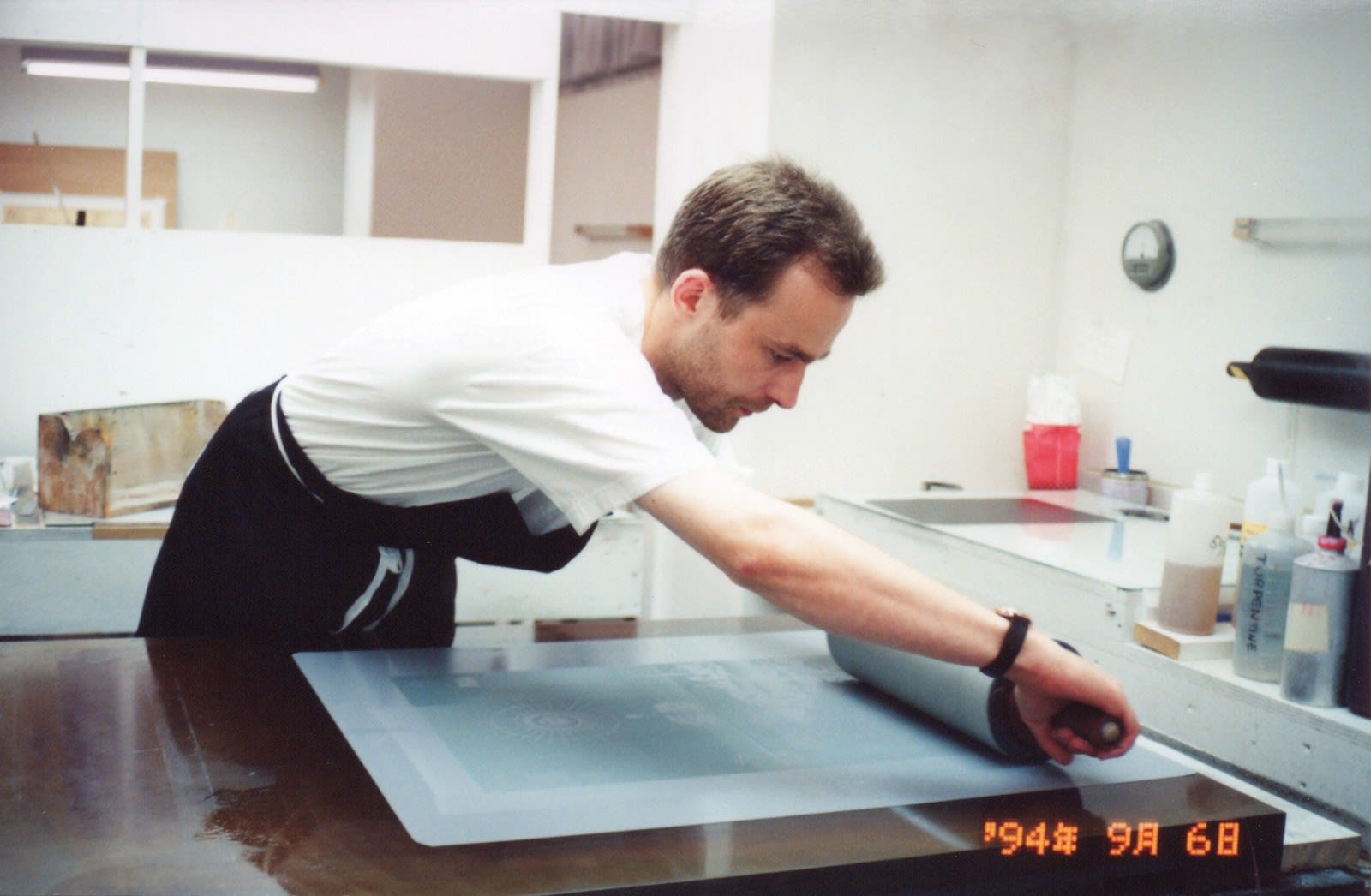
Robertson studied at Glasgow School of Art and maintains an interest in traditional fine art and printmaking. Originally working as the Lithographic Studio Printer at Glasgow Print Studio Robertson now concentrates on the research and application of new technologies, specifically digital imaging and printing. This influences current professional practice in the role of Master Printer at GPS managing the Digital Imaging Suite and disseminating that knowledge to others and as an individual artist.
The role of studio printer at GPS in the mediums of both lithography (1986-2002) and digital (2003-present) has always been on a part time basis allowing Robertson time to create and develop his own work. It has proven to be an ideal balance between two parallel streams of activity and commitment.
Robertson's career has evolved in tandem with, and is a reflection of, the growth of Glasgow Print Studio's influence within the Scottish visual arts industry and its reputation as a major national and international centre for excellence over the years promoting contemporary and innovative printmaking.
In 1990 the city of Glasgow was awarded and carried forward the prestigious title of European City of Culture. This acted as a catalyst and as the fulcrum for a series of visual arts projects involving artists and institutions throughout the city, attracting widespread international attention. GPS were ideally placed to take advantage of this opportunity as the new large workshop and gallery spaces developed in 1988 could accommodate a wide variety of activities and visitors.
Printmaking is an ideal vehicle for the exchange of ideas, techniques and practices. Techniques can be demonstrated and taught, ideas can be presented, discussed and debated. The language is unconfined by borders or nationality. From the original projects developed in the early 90s, GPS continues to engage at any opportunity with international artists and institutions.
Robertson has exhibited widely over the past 40 years in the UK and internationally. His works are held in many public and private collections. Of particular influence have been specific residencies and exchange programmes including Künsterlhaus Bethanien, Berlin, Germany (1989-93); Yamanaka Fine Arts Centre, Kyoto, Japan (1995), Svenska Yrkeshögskolan, Njkarleby, Finland (1999 & 2000), J.J. School of Art, Mumbai, India (2001 & 2003); Museo Grabado, Zacatecas, Mexico (2004) and most recently Lewis, Outer Hebrides (2013), Sabhal Mór Ostaig, Isle of Skye (2015-2016) and Ballinglen Arts Centre, County Mayo, Ireland (2019 & 2022).
Robertson's work is underpinned by enquiries into aspects of nature and the environment that lie at the core of many of our current concerns and scientific paradigms. Exploring and contrasting the significances of cultural perceptions and misconceptions, Robertson endeavours to interpret and create systems of representation via structured visual matrices that are realised as hopefully legible and meaningful patterns of knowledge.
Imagery develops from a process of experience, documentation and interpretation, employing a wide variety of techniques from traditional drawing and painting to 3D computer modeling. Diagrammatic representations and their related iconography motivates much work referencing sources including textbooks on natural history, early and contemporary printed maps, scientific/technological imagery and cultural icons.
-
 Murray Robertson, Scotia I (second edition), 2025£ 420.00
Murray Robertson, Scotia I (second edition), 2025£ 420.00 -
 Murray Robertson, A Tale Too Slow I, 2019£ 550.00
Murray Robertson, A Tale Too Slow I, 2019£ 550.00 -
 Murray Robertson, A Tale Too Slow II, 2023£ 470.00
Murray Robertson, A Tale Too Slow II, 2023£ 470.00 -
 Murray Robertson, The Last Caledonian Volcano, 2013£ 480.00
Murray Robertson, The Last Caledonian Volcano, 2013£ 480.00 -
 Murray Robertson, Lament, 2012£ 660.00
Murray Robertson, Lament, 2012£ 660.00 -
 Murray Robertson, High Auchensale to Ithaca, 2016£ 585.00
Murray Robertson, High Auchensale to Ithaca, 2016£ 585.00 -
 Murray Robertson, Glasgow - View from the Craw Stane, 2018£ 585.00
Murray Robertson, Glasgow - View from the Craw Stane, 2018£ 585.00 -
 Murray Robertson, Untrammelled, 2017£ 450.00
Murray Robertson, Untrammelled, 2017£ 450.00 -
 Murray Robertson, On the Hill of Bog Cotton, 2013£ 550.00
Murray Robertson, On the Hill of Bog Cotton, 2013£ 550.00 -
 Murray Robertson, Crucible (Sphagnum Denticulatum), 2013£ 640.00
Murray Robertson, Crucible (Sphagnum Denticulatum), 2013£ 640.00 -
 Murray Robertson, CAWL (Core Areas of Wild Land) I, 2015£ 420.00
Murray Robertson, CAWL (Core Areas of Wild Land) I, 2015£ 420.00 -
 Murray Robertson, CAWL (Core Areas of Wild Land) II, 2015£ 675.00
Murray Robertson, CAWL (Core Areas of Wild Land) II, 2015£ 675.00 -
 Murray Robertson, Ramasaig, 2015£ 675.00
Murray Robertson, Ramasaig, 2015£ 675.00 -
 Murray Robertson, Black Cuillin, 2015£ 675.00
Murray Robertson, Black Cuillin, 2015£ 675.00 -
 Murray Robertson, Na Garbh-chrìochan, 2015£ 675.00
Murray Robertson, Na Garbh-chrìochan, 2015£ 675.00 -
 Murray Robertson, Duirinish, 2015£ 675.00
Murray Robertson, Duirinish, 2015£ 675.00 -
 Murray Robertson, The Drunken Boat, 2018£ 420.00
Murray Robertson, The Drunken Boat, 2018£ 420.00 -
 Murray Robertson, Magnetic Resonance Imaging, 2006£ 650.00
Murray Robertson, Magnetic Resonance Imaging, 2006£ 650.00 -
 Murray Robertson, Three Little Words, 2012£ 480.00
Murray Robertson, Three Little Words, 2012£ 480.00 -
 Murray Robertson, Capsid Hexon Triptych, 2004£ 585.00
Murray Robertson, Capsid Hexon Triptych, 2004£ 585.00 -
 Murray Robertson, HBV Architecture I, 2007£ 450.00
Murray Robertson, HBV Architecture I, 2007£ 450.00 -
 Murray Robertson, Cytomegalovirus, 2007£ 450.00
Murray Robertson, Cytomegalovirus, 2007£ 450.00 -
 Murray Robertson, The Trouble with Wilderness I, 2015£ 750.00
Murray Robertson, The Trouble with Wilderness I, 2015£ 750.00 -
 Murray Robertson, The Trouble with Wilderness II, 2015£ 750.00
Murray Robertson, The Trouble with Wilderness II, 2015£ 750.00 -
 Murray Robertson, The Trouble with Wilderness III, 2016£ 220.00
Murray Robertson, The Trouble with Wilderness III, 2016£ 220.00 -
 Murray Robertson, An Cuiltheann, 2015£ 675.00
Murray Robertson, An Cuiltheann, 2015£ 675.00 -
 Murray Robertson, On the far side of the border, 2016£ 220.00
Murray Robertson, On the far side of the border, 2016£ 220.00 -
 Murray Robertson, Pearl Garden II, 2023£ 450.00
Murray Robertson, Pearl Garden II, 2023£ 450.00 -
 Murray Robertson, New Found Land, 2010£ 550.00
Murray Robertson, New Found Land, 2010£ 550.00 -
 Murray Robertson, Deep Waters I, 2010£ 550.00
Murray Robertson, Deep Waters I, 2010£ 550.00 -
 Murray Robertson, Law of the Sea, 2010£ 550.00
Murray Robertson, Law of the Sea, 2010£ 550.00 -
 Murray Robertson, Atlantic Low, 2010£ 550.00
Murray Robertson, Atlantic Low, 2010£ 550.00 -
 Murray Robertson, Queen of the Deep I, 2011£ 320.00
Murray Robertson, Queen of the Deep I, 2011£ 320.00 -
 Murray Robertson, Queen of the Deep II, 2011£ 320.00
Murray Robertson, Queen of the Deep II, 2011£ 320.00 -
 Murray Robertson, Stella Field, 1995£ 650.00
Murray Robertson, Stella Field, 1995£ 650.00 -
 Murray Robertson, Via Orientalis, 1994£ 550.00
Murray Robertson, Via Orientalis, 1994£ 550.00 -
 Murray Robertson, Cityscape & Tradition, 1995£ 650.00
Murray Robertson, Cityscape & Tradition, 1995£ 650.00 -
 Murray Robertson, Abraxus I, 1992£ 325.00
Murray Robertson, Abraxus I, 1992£ 325.00 -
 Murray Robertson, Prima Materia, 1992£ 480.00
Murray Robertson, Prima Materia, 1992£ 480.00 -
 Murray Robertson, Essential Balm, 2003£ 580.00
Murray Robertson, Essential Balm, 2003£ 580.00 -
 Murray Robertson, Navigators Dream, 2025£ 525.00
Murray Robertson, Navigators Dream, 2025£ 525.00 -
 Murray Robertson, A Brief Guide 2025, 2025£ 470.00
Murray Robertson, A Brief Guide 2025, 2025£ 470.00 -
 Murray Robertson, The Problem of Heresy 2025, 2025£ 585.00
Murray Robertson, The Problem of Heresy 2025, 2025£ 585.00 -
 Murray Robertson, Flat Earth Theory No. 1 2025, 2025£ 585.00
Murray Robertson, Flat Earth Theory No. 1 2025, 2025£ 585.00 -
 Murray Robertson, Certain Errors, 2025£ 585.00
Murray Robertson, Certain Errors, 2025£ 585.00 -
 Murray Robertson, Miracle & Ordeal, 1991£ 750.00
Murray Robertson, Miracle & Ordeal, 1991£ 750.00 -
 Murray Robertson, The Popelicants, 1991£ 580.00
Murray Robertson, The Popelicants, 1991£ 580.00 -
 Murray Robertson, Rationalism and the Natural Sciences, 1991£ 550.00
Murray Robertson, Rationalism and the Natural Sciences, 1991£ 550.00 -
 Murray Robertson, Vier+Four Berlin the Great Game, 1990£ 385.00
Murray Robertson, Vier+Four Berlin the Great Game, 1990£ 385.00 -
 Murray Robertson, Vier+Four in Facing Chaos, 1990£ 285.00
Murray Robertson, Vier+Four in Facing Chaos, 1990£ 285.00 -
 Murray Robertson, Vier+Four Chasing Bright Days, 1990£ 285.00
Murray Robertson, Vier+Four Chasing Bright Days, 1990£ 285.00 -
 Murray Robertson, Astronomical Theory, 1992£ 650.00
Murray Robertson, Astronomical Theory, 1992£ 650.00 -
 Murray Robertson, Where Angels Fear to Tread, 1989£ 650.00
Murray Robertson, Where Angels Fear to Tread, 1989£ 650.00 -
 Murray Robertson, Inevitable Conflict, 1991£ 420.00
Murray Robertson, Inevitable Conflict, 1991£ 420.00 -
 Murray Robertson, Kibble Palace, 1986£ 550.00
Murray Robertson, Kibble Palace, 1986£ 550.00 -
 Murray Robertson, Perils of the Soul, 1986£ 550.00
Murray Robertson, Perils of the Soul, 1986£ 550.00 -
 Murray Robertson, Ring of Fire, 1986£ 550.00
Murray Robertson, Ring of Fire, 1986£ 550.00 -
 Murray Robertson, The Mechanic, 1987£ 550.00
Murray Robertson, The Mechanic, 1987£ 550.00 -
 Murray Robertson, Catch a Fire, 1986£ 550.00
Murray Robertson, Catch a Fire, 1986£ 550.00 -
 Murray Robertson, Raindancer, 1987£ 550.00
Murray Robertson, Raindancer, 1987£ 550.00 -
 Murray Robertson, Messenger, 1986£ 220.00
Murray Robertson, Messenger, 1986£ 220.00 -
 Murray Robertson, Calydonian Boar Hunt, 1989£ 360.00
Murray Robertson, Calydonian Boar Hunt, 1989£ 360.00 -
 Murray Robertson, Visual Elements Periodic Table, 1999
Murray Robertson, Visual Elements Periodic Table, 1999 -
 Murray Robertson, The Drunken Boat, 2018
Murray Robertson, The Drunken Boat, 2018








